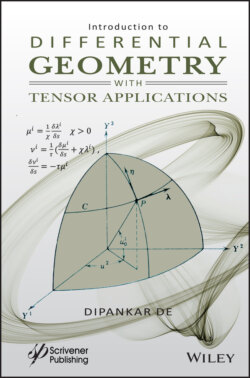Читать книгу Introduction to Differential Geometry with Tensor Applications - Группа авторов - Страница 2
Table of Contents
Оглавление1 Cover
2 Title Page
3 Copyright
4 Dedication
5 Preface
6 About the Book
7 Introduction
8 Part I: Tensor Theory 1 Preliminaries 1.1 Introduction 1.2 Systems of Different Orders 1.3 Summation Convention Certain Index 1.4 Kronecker Symbols 1.5 Linear Equations 1.6 Results on Matrices and Determinants of Systems 1.7 Differentiation of a Determinant 1.8 Examples 1.9 Exercises 2 Tensor Algebra 2.1 Introduction 2.2 Scope of Tensor Analysis 2.3 Transformation of Coordinates in Sn 2.4 Transformation by Invariance 2.5 Transformation by Covariant Tensor and Contravariant Tensor 2.6 The Tensor Concept: Contravariant and Covariant Tensors 2.7 Algebra of Tensors 2.8 Symmetric and Skew-Symmetric Tensors 2.9 Outer Multiplication and Contraction 2.10 Quotient Law of Tensors 2.11 Reciprocal Tensor of a Tensor 2.12 Relative Tensor, Cartesian Tensor, Affine Tensor, and Isotropic Tensors 2.13 Examples 2.14 Exercises 3 Riemannian Metric 3.1 Introduction 3.2 The Metric Tensor 3.3 Conjugate Tensor 3.4 Associated Tensors 3.5 Length of a Vector 3.6 Angle Between Two Vectors 3.7 Hypersurface 3.8 Angle Between Two Coordinate Hypersurfaces 3.9 Exercises 4 Tensor Calculus 4.1 Introduction 4.2 Christoffel Symbols 4.3 Transformation of Christoffel Symbols 4.4 Covariant Differentiation of Tensor 4.5 Gradient, Divergence, and Curl 4.6 Exercises 5 Riemannian Geometry 5.1 Introduction 5.2 Riemannian-Christoffel Tensor 5.3 Properties of Riemann-Christoffel Tensors 5.4 Ricci Tensor, Bianchi Identities, Einstein Tensors 5.5 Einstein Space 5.6 Riemannian and Euclidean Spaces 5.7 Exercises 6 The e-Systems and the Generalized Kronecker Deltas 6.1 Introduction 6.2 e-Systems 6.3 Generalized Kronecker Delta 6.4 Contraction of 6.5 Application of e-Systems to Determinants and Tensor Characters of Generalized Kronecker Deltas 6.6 Exercises
9 Part II: Differential Geometry 7 Curvilinear Coordinates in Space 7.1 Introduction 7.2 Length of Arc 7.3 Curvilinear Coordinates in E3 7.4 Reciprocal Base Systems 7.5 Partial Derivative 7.6 Exercises 8 Curves in Space 8.1 Introduction 8.2 Intrinsic Differentiation 8.3 Parallel Vector Fields 8.4 Geometry of Space Curves 8.5 Serret-Frenet Formula 8.6 Equations of a Straight Line 8.7 Helix 8.8 Exercises 9 Intrinsic Geometry of Surfaces 9.1 Introduction 9.2 Curvilinear Coordinates on a Surface 9.3 Intrinsic Geometry: First Fundamental Quadratic Form 9.4 Angle Between Two Intersecting Curves on a Surface 9.5 Geodesic in Rn 9.6 Geodesic Coordinates 9.7 Parallel Vectors on a Surface 9.8 Isometric Surface 9.9 The Riemannian–Christoffel Tensor and Gaussian Curvature 9.10 The Geodesic Curvature 9.11 Exercises 10 Surfaces in Space 10.1 Introduction 10.2 The Tangent Vector 10.3 The Normal Line to the Surface 10.4 Tensor Derivatives 10.5 Second Fundamental Form of a Surface 10.6 The Integrability Condition 10.7 Formulas of Weingarten 10.8 Equations of Gauss and Codazzi 10.9 Mean and Total Curvatures of a Surface 10.10 Exercises 11 Curves on a Surface 11.1 Introduction 11.2 Curve on a Surface: Theorem of Meusnier 11.3 The Principal Curvatures of a Surface 11.4 Rodrigue’s Formula 11.5 Exercises 12 Curvature of Surface 12.1 Introduction 12.2 Surface of Positive and Negative Curvature 12.3 Parallel Surfaces 12.4 The Gauss-Bonnet Theorem 12.5 The n-Dimensional Manifolds 12.6 Hypersurfaces 12.7 Exercises
10 Part III: Analytical Mechanics 13 Classical Mechanics 13.1 Introduction 13.2 Newtonian Laws of Motion 13.3 Equations of Motion of Particles 13.4 Conservative Force Field 13.5 Lagrangean Equations of Motion 13.6 Applications of Lagrangean Equations 13.7 Himilton’s Principle 13.8 Principle of Least Action 13.9 Generalized Coordinates 13.10 Lagrangean Equations in Generalized Coordinates 13.11 Divergence Theorem, Green’s Theorem, Laplacian Operator, and Stoke’s Theorem in Tensor Notation 13.12 Hamilton’s Canonical Equations 13.13 Exercises 14 Newtonian Law of Gravitations 14.1 Introduction 14.2 Newtonian Laws of Gravitation 14.3 Theorem of Gauss 14.4 Poisson’s Equation 14.5 Solution of Poisson’s Equation 14.6 The Problem of Two Bodies 14.7 The Problem of Three Bodies 14.8 Exercises
11 Appendix A: Answers to Even-Numbered Exercises
12 References
13 Index
14 Also of Interest
15 End User License Agreement
